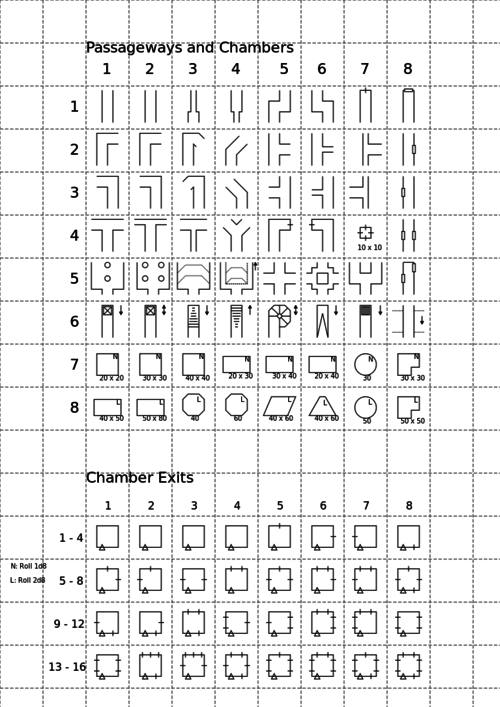D8 Random Dungeon (5e Variant Rule)
D8 Random Dungeon
I found myself wanting to use the DMG random dungeon generator, but only had a d8 and d10 to hand.
Passageways and Chambers
| Click to view original size. |
This is a d88 table that combines the passageways, passage width and chambers tables. Passages on the table are drawn as though you are travelling in a bottom-to-top page direction. With a passage width of 15 ft. or less, passage length is 30 ft. With a passage width of 20 ft. or greater, passage length is 50 ft.
- Passage Width
Some passages on the table increase or decrease the passageway width (for example, the T-junctions at 42 and 43) The progression is:
2 1/2 ft. ↔ 5 ft. ↔ 10 ft. ↔ 15 ft. ↔ 20 ft. ↔ 30 ft.
At your discretion you can skip the 15 ft. width, or have widths greater than 30 ft. depending on the style of dungeon you want.
- Passage Angles
Most passageway turns and junctions have 90 degree angles. Some, such as 23 and 24, have 45 degree angles, so two of such turns will set you back on an orthogonal path. If this does not suit the style of your dungeon (or your drawing capabilities), substitute these entries with their 90 degree equivalents.
- Doors
A thin rectangle set in a wall (18, 28, 38, 48, 58) represents a door. A dead end with a perpendicular line (17, 45, 46, 47) represents a 1-in-8 chance of a secret door.
- Special Areas
- 47 – A 10 × 10 ft. chamber with a 1-in-8 chance of a secret door on each wall (apart from the entrance wall).
- 51 – Passageway width becomes 30 ft., resumes to original width when passageway width changes again. A row of pillars runs down the centre
- 52 – As 51, but with two rows of pillars
- 53 – As 51; grand hallway with 20 ft. ceiling
- 54 – As 53; gallery 10 ft. high runs around the edge, provides access to level above
- 56 – Crossroads with central block, creating a "round-a-bout"
- 61 – Shaft going down to the next level
- 62 – Shaft going up and down to the level above and below
- 63 – Stairs down
- 64 – Stairs up
- 65 – Spiral staircase going up and down
- 66 – Slide or chute going down
- 67 – Trapdoor or grate to level below
- 68 – Bridge or balcony overlooking level below. Roll d88 to determine what is underneath.
- 71–78 – Normal-sized chambers
- 81–88 – Large-sized chambers
Chamber Exits
Roll 1d8 for normal chambers and 2d8 for large chambers to determine the table row; roll d8 to determine column. Chamber diagrams show the entrance as triangle, and the positions of the other exits.
For each exit, roll 1d8. On a 1–4 the exit is a door. On a 5–8 the exit is a 10 ft. long passageway.
Doors
| d88 | 1–6 | 7–8 |
|---|---|---|
| 1–3 | Weak | Weak; barred or locked |
| 4–5 | Strong | Strong; barred or locked |
| 6 | Gate | Gate; locked or barred |
| 7 | Portcullis | Portcullis; locked in place |
| 8 | Secret door | Secret door; barred or locked |
"Weak" and "Strong" doors are defined by your dungeon style. Examples might be:
- Wooden / Stone
- Stone / Iron
- Paper / Brass
- Mirror / Force
Gates and portcullises are made from strong wood reinforced with iron. You can draw line of sight through them, although they grant cover.
Back to Main Page → 5e Homebrew → Rules
